|
|
 |
|
Calanoida ( Order ) |
|
|
|
Clausocalanoidea ( Superfamily ) |
|
|
|
Diaixidae ( Family ) |
|
|
|
Diaixis ( Genus ) |
|
|
| |
Diaixis hibernica (A. Scott, 1896) (F,M) | |
| | | | | | | Syn.: | Scolecithrix hibernica A. Scott, 1896 (p.362, figs.F,M); Giesbrecht & Schmeil, 1898 (p.47, Rem.F,M); T.Scott, 1902 (p.451) | | | | Ref.: | | | Sars, 1902 (1903) (p.59, figs.F,M); Rose, 1933 a (p.160, figs.F,M); Marques, 1959 (p.212, figs.F,M); Vervoort, 1965 (p.87, Rem.); Marques, 1966 (p.3, fig.M); Vives, 1966 (p.80, figs.F,M); Vilela, 1968 (p.20, figs.F,M); Corral Estrada & Genicio de Corral, 1970 (p.26, figs.F); Razouls, 1972 (p.94, Annexe: p.58, figs.F,M); Andronov, 1979 (p.98-99); Bradford & al., 1983 (p.123); Ferrari & Markhaseva, 1996 (p.280, figs.F,M); Andronov, 2002 (p.20, figs.F,M, Juv.M); Boxshall & Halsey, 2004 (p.96, 97: figs.F,M); Vives & Shmeleva, 2007 (p.640, figs.F,M, Rem.); Blanco-Bercial & al., 2011 (p.103, Table 1, Biol. mol, phylogeny); Laakmann & al., 2019 (p.330, fig. 2, phylogenetic relationships) | 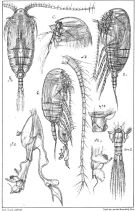 issued from : G.O. Sars in An Account of the Crustacea of Norway. Vol. IV. Copepoda Calanoida. Published by the Bergen Museum, 1903. [Pl. XXXIX]. Female & Male.
|
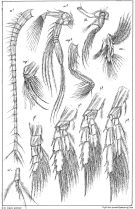 issued from : G.O. Sars in An Account of the Crustacea of Norway. Vol. IV. Copepoda Calanoida. Published by the Bergen Museum, 1903. [Pl. XL]. Female. Nota: M = Md; m = Mx1; mp1 = Mx2; mp2 = Mxp.
|
 issued from : F.D. Ferrari & E.L. Markhaseva in Proc. Biol. Soc. Washington, 1996, 109 (2). [p.281, Fig.9]. Female (from Raunefjord, Norway): A, Mx1 (posterior); B, Mx2 inner lobes 1-4 on syncoxa (posterior), lobe 5 with 1 seta cutoff also shown; C, Mx2 (inner lobe 5 on basis and inner lobe 6 + exopod (anterior); D, Mxp (setation of endopod not shown); E, Mxp (endopod, b= distal tip of basis, numbers indicate relative appearance of ramal segments during development); F, P1 (endopod, anterior; arrow indicates approximate position of presumptive boundary between endopod 1 and 2, between proximal two medial setae); G, P1 (endopod, posterior). bars: 1 = 0.1 mm (A-D); 2 = 0.1 mm (E); 3 = 0;1 mm (F, G). Nota: Mx1 with outer lobe with 8 setae; exopod 1-segmented with 8 setae; baseoendopod with sets of 3, 3, 3, and 3 setae; inner lobes: 1 with 8 apical setae, 2 with 2 setae, 3 with 3 setae. Mx2 with innerl lobes 1-4 on coxa each with 4, 3, 3, 3 setae, respectively; inner lobe 5 on basis with 4 setae; inner lobe 6 + exopod an indistintly segmented complex with 8 Bradford's setae (terminal 3thick without setules, 5 thinner with apical setules)
|
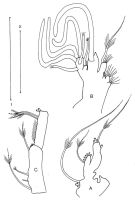 issued from : F.D. Ferrari & E.L. Markhaseva in Proc. Biol. Soc. Washington, 1996, 109 (2). [p.282, Fig.10]. Male: A, Mx1 (posterior); B, Mx2; C, Mxp (coxa and basis). Bars: 1 = 0.1 mm (A, B); 2 = 0.1 mm (C)
|
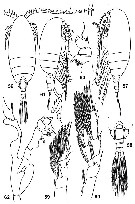 issued from : V.N. Andronov in Arthropoda Selecta, 2002, 11 (1). [p.22, Figs.56-63]. After Sars, 1903. Female: 56-57, habitus (dorsal and lateral, respectively); 58, corners of thoracic segment 5 and urosome (dorsal); 59, P1; 60, P4. Male: 61, habitus (lateral); 62, P5; 63, distal end of left P5.
|
 issued from : V.N. Andronov in Arthropoda Selecta, 2002, 11 (1). [p.23, Figs.64-69]. Female: 64, thoracic segment 5, genital segment and urosomal segment 2 (dorsal); 65, genital segment (ventral); 66-67, thoracic segments 4 and 5 (left and right views, respectively); 68, Mx2; 69, one of brush-like setae on endopod of Mx2.
|
 ssued from : V.N. Andronov in Byull. Mosk. Obshch. Ispyt. Prir. , Otdel Biol., n. ser., 1979, 84 (4). [p.98, Figs.1-5]. As Diaixis hibernica tropica. Female: 1, genital segment (ventral); 2, 4, last thoracic segments (lateral left and right side, respectively); 3, last thoracic segment and urosomal segments 1 and 2; 5, one of the brush-like setae of Mx2.
|
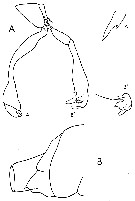 issued from : C. Razouls in Th. Doc. Etat Fac. Sc. Paris VI, 1972, Annexe. [Fig.46]. Female (from Banyuls, G. of Lion): B, posterior part of metasome (lateral). Male: A, P5; A'-B', distal end of terminal segments (enlarged).
| | | | | Compl. Ref.: | | | Pearson, 1906 (p.19, Rem.); Djordjevic, 1963 (p.576, 578: Rem.); Mazza, 1966 (p.71); Neto & Paiva, 1966 (p.24, Table III); Matthews, 1967 (p.159, Table 1, Rem.); Bainbridge, 1972 (p.61, Appendix Table I: vertical distribution vs day/night); Binet & al., 1972 (p.69); Dessier, 1979 (p.132, 201, 205); Kovalev & Shmeleva, 1982 (p.84); Vives, 1982 (p.292); Lozano Soldevilla & al., 1988 (p.58); Falkenhaug & al., 1997 (p.449, spatio-temporal pattern); Sautour & al., 2000 (p.531, Table II, abundance); d'Elbée, 2001 (tabl.1); Holmes, 2001 (p.54, Rem.); Beaugrand & al., 2002 (p.179, figs.5, 6); Bode & al., 2003 (p.85, Table 1, abundance); Fernandez de Puelles & al., 2007 (p.338, fig.7); Valdés & al., 2007 (p.104: tab.1); Cabal & al., 2008 (289, Table 1); Eloire & al., 2010 (p.657, Table II, temporal variability); Belmonte & al., 2013 (p.222, Table 2, abundance vs stations); Sobrinho-Gonçalves & al., 2013 (p.713, Table 2, seasonal abundance vs environmental conditions); Belmonte, 2018 (p.273, Table I: Italian zones) | | | | NZ: | 4 | | |
|
Distribution map of Diaixis hibernica by geographical zones
|
| | | | | | | | |  Chart of 1996 Chart of 1996 | |
| | | | Loc: | | | Angola, Baia Farta, Congo, G. of Guinea, Ivorian shelf, Morocco-Mauritania, Canary Is., Portugal, off Coruña, S Bay of Biscay, off Gironde estuary, Ireland, Scotland, Loch Etive, W Norway, Malangen fjord, Raunefjorden (all the year), North Sea, W Medit. ( Villefranche-sur-mer, Marseille, Banyuls, Castellon, Taranto) | | | | N: | 36 | | | | Lg.: | | | (16) F: 0,73; M: 0,649; (47) F: 1,2; (54) F: 0,83; M: 0,79-0,71; (65) F: 1,2; M: 1,1; (327) F: 0,91-0,76; M: 0,81-0,68; (379) F: 1,04-0,94; M: 0,94-0,88; (381) F: 1,2; (881) F: 0,94-1,2; M: 0,88-1,1; {F: 0,73-1,20; M: 0,65-1,10} | | | | Rem.: | hyperbenthic (bottom dweller, living on or in the vicinity of a soft, muddy bottom of moderately deep to deep water), inshore; 110 m in Loch Etive (Scotland). | | | Last update : 05/02/2020 | |
|
|
 Any use of this site for a publication will be mentioned with the following reference : Any use of this site for a publication will be mentioned with the following reference :
Razouls C., Desreumaux N., Kouwenberg J. and de Bovée F., 2005-2025. - Biodiversity of Marine Planktonic Copepods (morphology, geographical distribution and biological data). Sorbonne University, CNRS. Available at http://copepodes.obs-banyuls.fr/en [Accessed October 08, 2025] © copyright 2005-2025 Sorbonne University, CNRS
|
|
 |
 |










